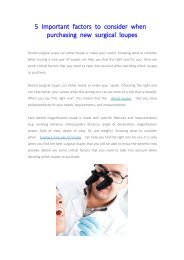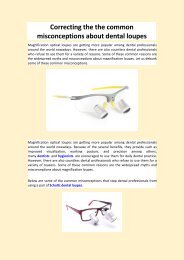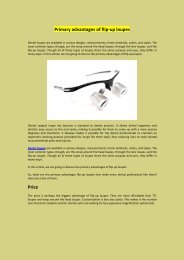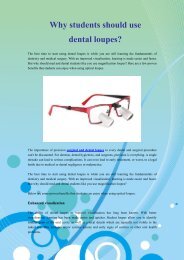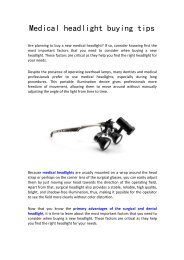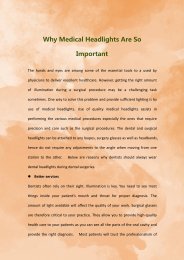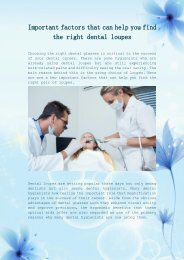Factors to consider when choosing the best loupes for dentistry
Dental loupes surely offer many advantages. However, the number of benefits you can get out of using the optical magnification loupes is rather limited if you fail to pick the right one for you. Here are a few factors that can help you find the best loupes for dentistry.
Dental loupes surely offer many advantages. However, the number of benefits you can get out of using the optical magnification loupes is rather limited if you fail to pick the right one for you. Here are a few factors that can help you find the best loupes for dentistry.
Create successful ePaper yourself
Turn your PDF publications into a flip-book with our unique Google optimized e-Paper software.
Dentists <strong>loupes</strong> are not created equal. They are available in different styles, types,<br />
frame color, measurements, and magnification power. The magnification power of<br />
dental magnifying <strong>loupes</strong> ranges from 2.5.x <strong>to</strong> 6.0x.<br />
It is important that you know how and where you will use <strong>the</strong> dental <strong>loupes</strong> in order <strong>to</strong><br />
pick <strong>the</strong> right magnification power. If you intend <strong>to</strong> use <strong>the</strong> <strong>loupes</strong> <strong>for</strong> general<br />
<strong>dentistry</strong>, a 2.5x magnification is enough <strong>for</strong> you. However, if you plan <strong>to</strong> use it <strong>for</strong><br />
more complicated dental procedures that require more power and higher levels of<br />
precision, you can opt <strong>for</strong> 4.0x or higher magnification.<br />
Working Distance<br />
The working distance is <strong>the</strong> measurement of <strong>the</strong> distance between your eyes and your<br />
patient’s oral cavity. The right working distance will allow you <strong>to</strong> work in an upright<br />
and neutral position (both sitting and standing positions) and enables you <strong>to</strong> see <strong>the</strong><br />
region you are working on clearly and closely even without leaning <strong>for</strong>ward <strong>to</strong>wards<br />
your patient’s mouth.<br />
Taking your working distance is quite easy. You just need a measuring tape. Put one<br />
end of <strong>the</strong> tape on <strong>the</strong> upper bridge of your nose and <strong>the</strong> o<strong>the</strong>r end of <strong>the</strong> mouth of<br />
your patient. Take <strong>the</strong> measurement and that’s it.<br />
Weight<br />
The weight is a critical fac<strong>to</strong>r that you need <strong>to</strong> take a closer look at. As much as<br />
possible, pick <strong>the</strong> Schultz loupe with <strong>the</strong> lightest weight. The weight, no matter how<br />
light it is, can build up over time most especially if you use <strong>the</strong> loupe all day long.<br />
When <strong>the</strong> weight starts <strong>to</strong> build up, it can affect your com<strong>for</strong>t and focus and it can as<br />
well lead <strong>to</strong> strains on your neck and nose bridge. Smart dentists pick a pair of dental<br />
<strong>loupes</strong> that is very light and portable.




